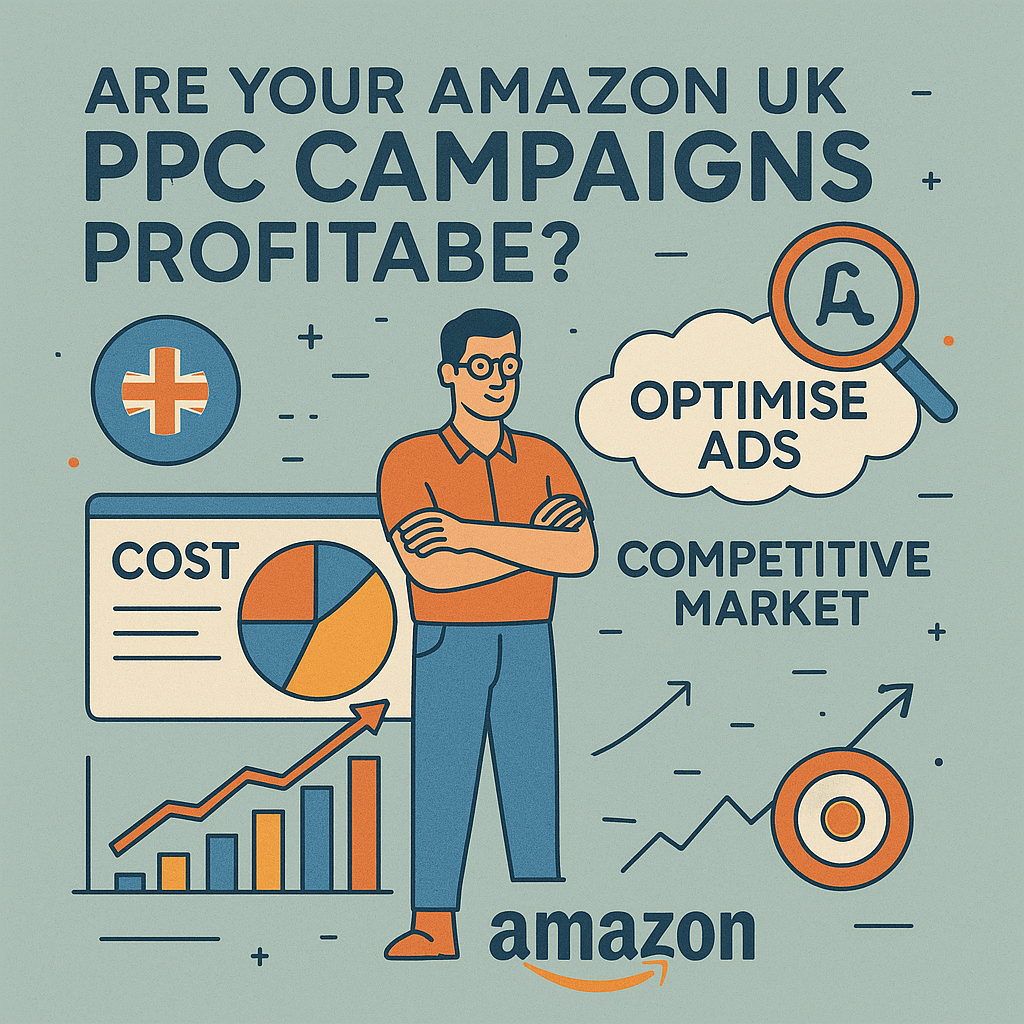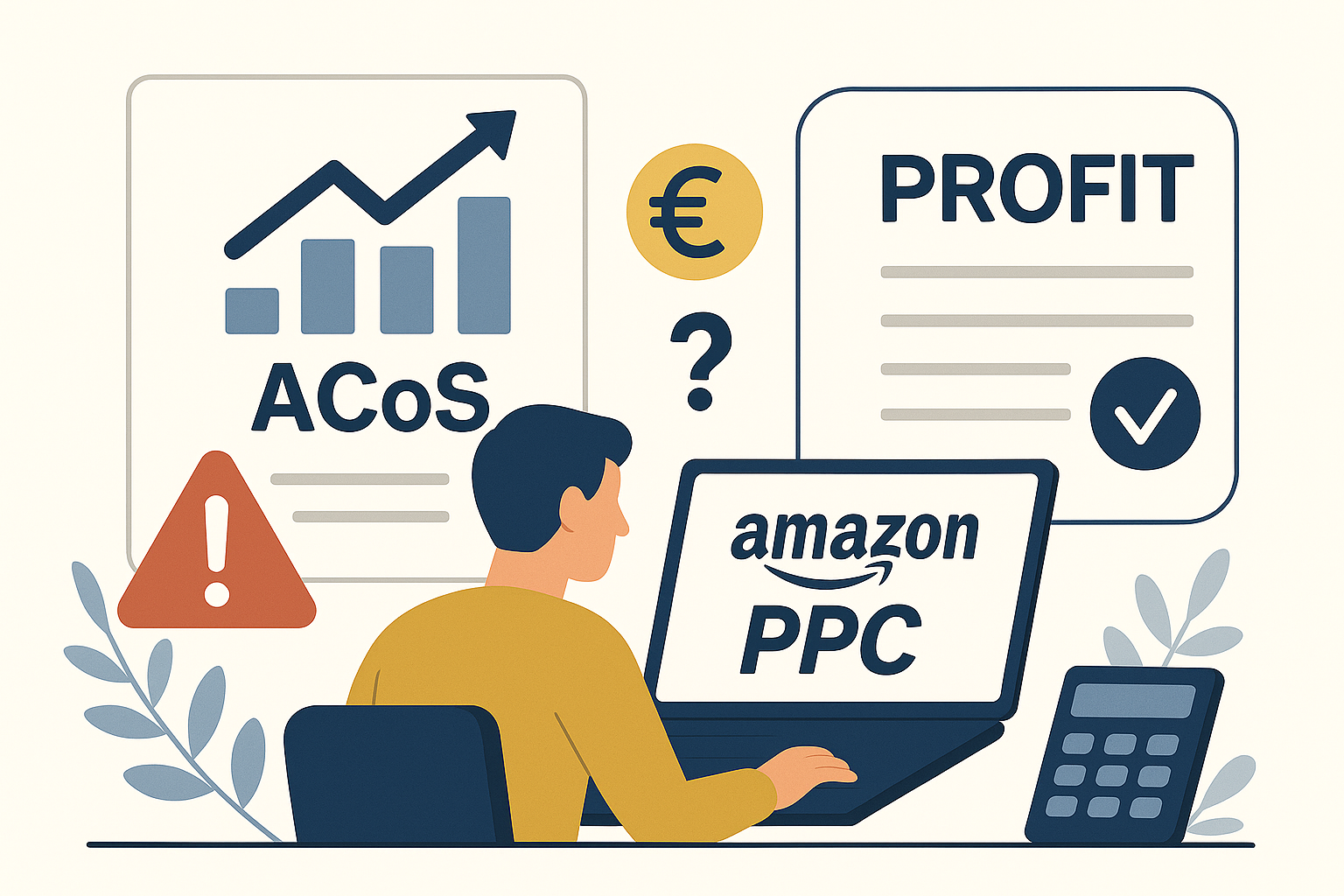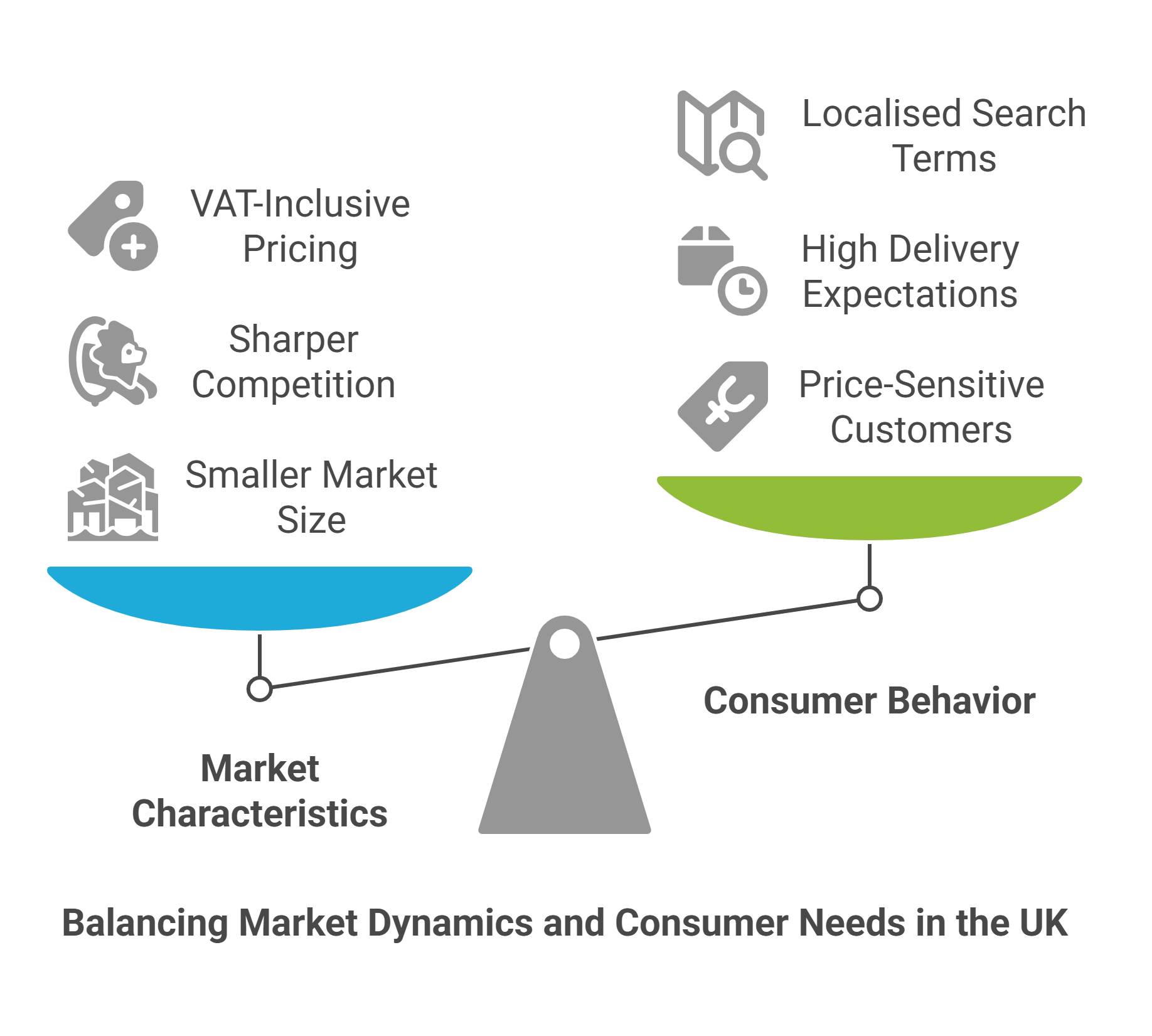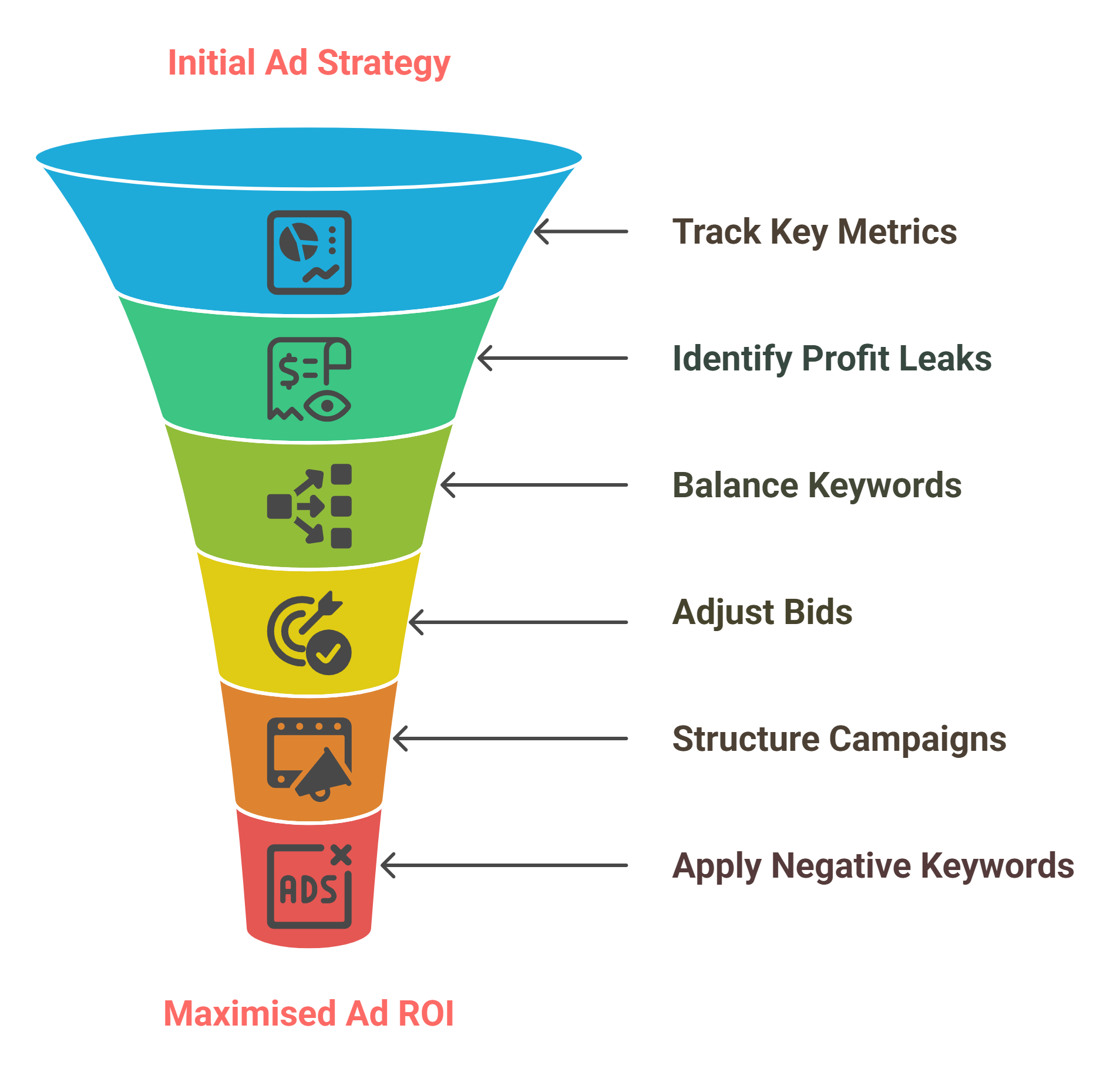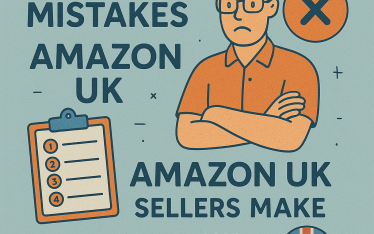TL;DR
- UK Amazon PPC needs a tailored strategy—smaller market, tighter margins, and more price-sensitive shoppers mean every ad pound must perform.
- Track profitability, not just clicks—focus on ACoS, TACoS, ROAS, and break-even points to ensure your ads are actually making money.
- Factor in VAT, FBA fees, and shipping to avoid hidden losses and price your bids accurately.
- Use a mix of high-volume and long-tail keywords for better reach and cost-efficiency; don’t rely on broad terms alone.
- Apply negative keywords, optimise bids by performance, and use Amazon reports to eliminate waste and sharpen targeting.
- Align PPC with organic ranking and sales goals—ads should support long-term growth, not just short-term traffic.
Running Amazon ads in the UK?
Don’t assume what works elsewhere will work here. The UK market plays by different rules and if your PPC strategy isn’t tailored, you’re likely burning ad spend without real results. Many sellers focus on impressions and clicks, but the real question is: are your ads actually profitable? Are they driving growth, or quietly cutting into your margins?
With rising competition, shifting buyer behavior, and tighter ad budgets, UK Amazon sellers need a smarter, data-driven approach to PPC. It’s not just about spending more—it’s about spending wisely.
In this blog, we’ll break down why UK PPC demands a different mindset, what makes the market unique, and how to optimise your campaigns for sustainable growth. From tracking the right metrics to fixing hidden leaks, you’ll learn how to turn underperforming ads into profit engines—and how to structure your campaigns to win in a competitive space.
Why does the UK PPC need a different mindset?
Amazon PPC in the UK isn’t just a scaled-down version of your US or EU strategy—it’s a different game altogether. UK shoppers behave differently, budgets are tighter, and the market is smaller but highly competitive. You can’t simply copy-paste your campaigns and expect the same results.
Here’s why a unique approach is essential:
| Reason | Why it matters |
| Smaller market size | Fewer impressions mean you need to be more precise with targeting and budgeting. |
| Price sensitivity | UK buyers are more deal-focused—ads need to convert with strong value propositions. |
| Regional buying behavior | Keywords and peak times differ; you must localise your campaigns accordingly. |
| Tighter margins | High ACoS is harder to justify—every penny counts, so ROI is king. |
| Slower product adoption | New products may take longer to gain traction, requiring patient, strategic scaling. |
Success in the UK market means prioritising profit over volume, testing more frequently, and applying tighter controls. When it comes to Amazon advertising, adopting a smarter, more strategic mindset is what sets winning sellers apart.
Are your ads actually profitable?
It’s easy to assume your Amazon PPC campaigns are working just because you’re getting clicks and sales—but that doesn’t always mean you’re making money. For UK sellers, where margins can be tighter and competition is fierce, understanding your ad profitability is essential.
Start by looking beyond just ACoS.
Are your ads helping you earn more than you spend?
Check your TACoS (total advertising cost of sales), ROAS (return on ad spend), and most importantly your break-even point. If your ACoS is higher than your profit margin, you’re losing money, even if sales are coming in.
Track profit per ASIN, factor in VAT, FBA fees, and shipping. Don’t ignore the hidden costs. Profitable Amazon sponsored ads should drive long-term growth, not just short-term sales. Focus on campaigns that boost both paid and organic sales and cut what isn’t working. That’s how you keep PPC sustainable in the UK market.
What’s unique about the UK market?
Understanding the UK market is key to running profitable Amazon PPC campaigns. Here’s what sets it apart:
- Smaller market, sharper competition: Fewer buyers than the US means every click counts—there’s less room for wasted spend.
- VAT-inclusive pricing: UK shoppers see VAT-inclusive prices, so your margins may be tighter than expected. Factor this into your bid strategy.
- More price-sensitive customers: UK buyers are deal hunters. Offers, coupons, and competitive pricing influence click-through and conversion rates.
- Localised search terms matter: UK English differs from US English. “Trainers” not “sneakers,” “bin” not “trash”—use UK-specific keywords.
- Delivery expectations are high: Prime delivery is expected. Delays hurt conversions more than in other regions.
- Seasonality and trends vary: Events like Boxing Day, bank holidays, or weather patterns influence buyer behaviour in unique ways.
- Regulations and compliance: Products must meet UK safety and labeling standards—non-compliance can impact ad eligibility.
Tailoring your approach to these realities helps your campaigns perform smarter, not just bigger.
How much does Amazon advertising cost in the UK?
| Ad type | How it works | Typical cost (CPC) | What affects cost |
| Sponsored Products | Promotes individual listings in search results and product pages | £0.30 – £0.90 per click | Keyword competition, category, bid strategy |
| Sponsored Brands | Shows your brand logo and multiple products in search results | £0.50 – £1.20 per click | Branded vs. non-branded keywords, creative quality |
| Sponsored Display | Targets shoppers on and off Amazon based on behavior and interests | £0.35 – £1.00 per click | Audience targeting, product relevance, competition |
| Amazon DSP (Display Ads) | Programmatic ads across Amazon and third-party sites | £0.50+ CPM (cost per 1,000 impressions) | Audience size, targeting depth, placement |
How to optimise ads in a competitive market
-
Track ACoS, TACoS, ROAS, and break-even to guide decisions
In a competitive market like Amazon UK, tracking the right metrics is essential to make smart PPC decisions. Start with ACoS (Advertising Cost of Sales) to see how much you’re spending per sale, but don’t stop there. Use TACoS (Total Advertising Cost of Sales) to understand how ads impact your overall sales, not just paid ones.
Moreover, ROAS (Return on Ad Spend) helps you measure how efficiently your ad budget is working—higher ROAS means better returns. Most importantly, know your break-even ACoS. If your ACoS is higher than your margin, you’re losing money.
It includes all UK-specific costs like VAT, FBA fees, and shipping to get accurate numbers. Tracking these KPIs consistently helps you spot underperforming campaigns early and optimise for real, profitable growth. In a competitive market like Amazon UK, lower ACoS comes from focusing on the right keywords, improving your targeting, and adjusting your bids to get better results without overspending.
-
Find profit leaks and fix them before they drain your budget
In a competitive market like Amazon UK, even small leaks in your PPC strategy can quietly eat into your profits. It is majorly due to High ACoS campaigns, irrelevant keywords, and overspending on low-converting search terms. Start by reviewing your search term reports—are you paying for clicks that don’t convert? If so, add them as negative keywords.
Next, check your campaigns for high spend but low return—these ASINs may need pricing adjustments, better images, or removal from ads altogether. Don’t forget hidden costs like VAT and FBA fees—factor them into your profit calculations, not just your sales numbers.
Regular audits and fine-tuning help you stop the budget bleed. In the UK, where margins are tight, fixing leaks isn’t just good practice—it’s essential for building a profitable PPC strategy in the UK and staying ahead of the competition.
-
Balance high-volume and long-tail keywords for better reach
In the UK’s competitive Amazon marketplace, relying only on high-volume keywords can quickly drain your budget without guaranteed returns. These broad terms are expensive, highly competitive, and often convert poorly.
To optimise your PPC ads, UK sellers need a balanced keyword strategy. Mix in long-tail keywords—more specific phrases with lower search volume but higher intent. For example, instead of just bidding on “water bottle,” use terms like “BPA-free gym water bottle 1L.”
Long-tail keywords are often cheaper, more targeted, and deliver better ROI, especially in a price-sensitive market like the UK. They also help you reach niche customer segments who are ready to buy. So, review your search term reports regularly and adjust bids to strike the right balance between reach, cost, and conversion. That’s how you grow efficiently without overspending.
-
Set, adjust, and test bids to maximise ROI
In a competitive market like Amazon UK, blindly setting bids isn’t enough—you need a hands-on, data-driven approach. Start by identifying your most profitable keywords and setting bids based on performance, not just volume.
High ACoS? Lower the bid or pause it. Low ACoS but strong sales? Scale it up strategically.
Don’t “set and forget.” UK traffic is smaller, so each bid carries more weight. Test bid changes in small increments and monitor how they affect impressions, conversions, and cost-per-click. You also need to consider time-based adjustments, UK buyers may shop more during evenings or weekends. Use dayparting to schedule bids around these patterns.
Thus, regularly adjusting your bids based on real data is one of the simplest ways to reduce wasted spend and increase ROI in the UK market.
-
Structure Sponsored Products, Brands, and Display campaigns
In a highly competitive UK marketplace, the way you structure your Amazon ads can significantly impact your performance. Avoid launching all ad types at once—each format serves a specific objective and should be used strategically.
- Use Amazon Sponsored Products to target high-intent keywords and drive direct sales. Here, structure your campaigns by product category or performance tier to manage budgets and bids more effectively.
- Sponsored Brands are great for visibility—especially when launching new products or building brand recall. Use headline copy that matches UK search language and value-driven messaging.
- Sponsored Display helps retarget shoppers and defend your listings. Target competitor ASINs or use audience segments based on browsing behavior.
A well-structured campaign setup allows for better tracking, easier optimization, and smarter budget allocation—especially important in the UK, where every pound must work harder. Effective Amazon Sponsored Ads management in the UK ensures your ad spend delivers measurable results and supports long-term growth.
-
Apply negative keywords to cut out wasted spend
Every pound of ad spend on Amazon UK needs to deliver results. A highly effective way to optimise your PPC campaigns is by using negative keywords—these prevent your ads from showing irrelevant or low-converting search terms.
UK buyers often use very specific, localized phrases. If you’re not careful, your ads may show up for unrelated or overly broad keywords, wasting spend and dragging down your ACoS.
For example, if you’re selling premium leather wallets, you don’t want to show up for searches like “cheap wallet” or “wallet case for phone.”
So, regularly review your search term reports and add negative keywords to filter out unqualified traffic. This keeps your campaigns focused, reduces wasted spend, and improves your return on every click.
-
Use Amazon reports and data to sharpen performance
Guesswork isn’t enough in the UK market—you need to let data guide your decisions. Amazon offers powerful reports that help you fine-tune your PPC campaigns for better performance and efficiency.
- Start with the Search Term Report to find which keywords are converting and which are wasting spend. Use the Performance Over Time report to spot trends in ACoS, CTR, and conversion rates.
- Focus on metrics that matter like click-through rate (CTR) shows ad relevance, while conversion rate reveals if your listing is doing its job. If people are clicking but not buying, your listing—not your ad—might be the issue.
As a UK seller, you should also monitor performance by device, location, and time of day to adjust bids for when and where customers actually convert.
-
Align PPC strategy with organic ranking and sales growth
Running ads independently is unlikely to yield sustained success. To achieve meaningful results in the UK Amazon market, it is essential to align your PPC strategy with long-term organic growth objectives. Smart UK sellers treat ads as a tool to boost visibility, drive reviews, and improve organic ranking—not just to chase short-term sales.
- Focus on high-converting keywords that appear in both your ads and product listings. This builds relevance and improves ranking over time. Use PPC to push new products, seasonal offers, or slow movers, but monitor how they impact your organic traffic and sales.
- Track your TACoS regularly. A falling TACoS often signals that your organic sales are catching up—meaning your ads are working. The goal is not just more ad sales, but more overall profit. That’s how you win in a competitive market.
Moreover, partnering with an experienced Amazon PPC agency in the UK can help you, as a seller, navigate complex ad strategies, optimise campaigns, and achieve better returns on your advertising spend.
Is your Amazon UK PPC truly working?
Optimising your Amazon UK PPC campaigns isn’t just about getting more clicks—it’s about turning those clicks into profit. With a smaller market, price-sensitive customers, and tighter margins, UK sellers need to be strategic, data-driven, and cost-conscious.
From tracking the right metrics to refining keyword targeting and using Amazon reports effectively, every decision should be tied to sustainable growth. Aligning your PPC with organic sales, fixing profit leaks, and structuring campaigns with purpose can help you compete smarter—not harder.
Feeling overwhelmed? Partnering with an experienced Amazon agency in the UK can help you make sense of the data, fine-tune your strategy, and maximise your ad spend. With the right team behind you, your UK campaigns can drive long-term, profitable growth.
